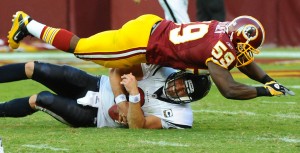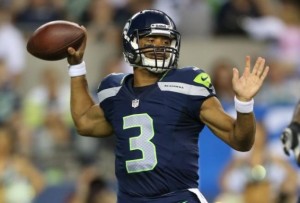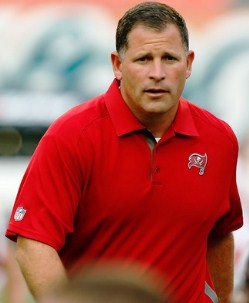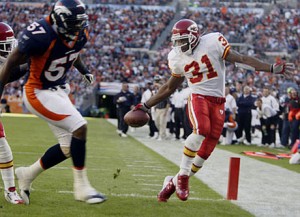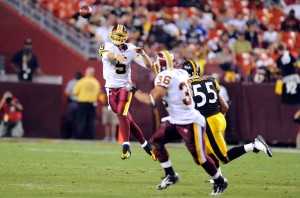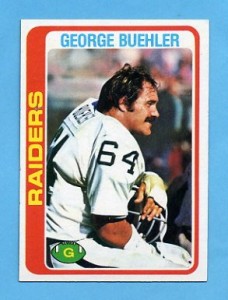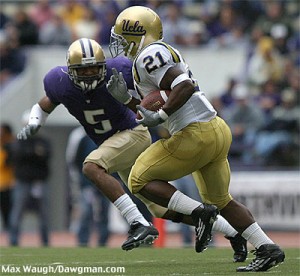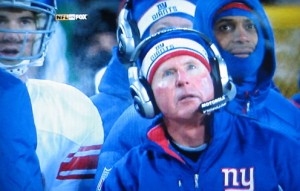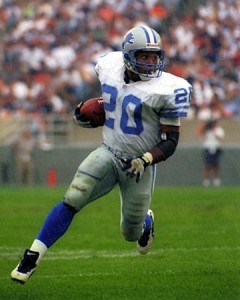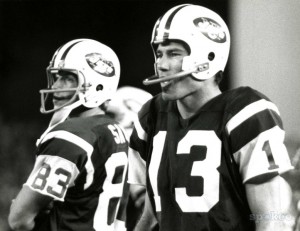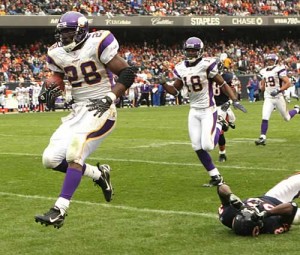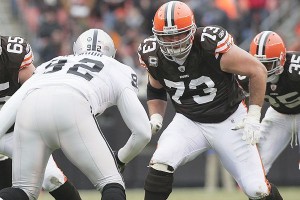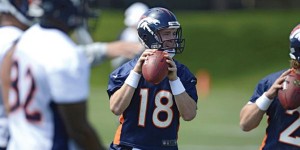Using the same formula, we can grade each quarterback in each game and adjust for era [1]Note that I do not have individual playoff sack data prior to 2008, so I am using pro-rated sack numbers based on team sack data.. However, it should be obvious that the sample sizes here are incredibly small, and the stats are even less likely to tell the true story when looking at just one game. Strength of schedule becomes a significant factor here, as well. But, caveats aside, there’s a lot we can do with playoff data. For example, we can rank every quarterback performance in Super Bowl history:
| Rk | QB | Tm | Opp | SB | W/L | Att | Pyd | TD | INT | CY | CYP | VAL |
|---|---|---|---|---|---|---|---|---|---|---|---|---|
| 1 | Joe Montana | SFO | MIA | 19 | W | 35 | 331 | 3 | 0 | 406 | 11 | 272 |
| 2 | Steve Young | SFO | SDG | 29 | W | 36 | 325 | 6 | 0 | 431 | 11.1 | 264 |
| 3 | Troy Aikman | DAL | BUF | 27 | W | 30 | 273 | 4 | 0 | 381 | 12.3 | 258 |
| 4 | Joe Montana | SFO | DEN | 24 | W | 29 | 297 | 5 | 0 | 397 | 13.3 | 256 |
| 5 | Kurt Warner | STL | TEN | 34 | W | 45 | 414 | 2 | 0 | 447 | 9.7 | 225 |
| 6 | Jim Plunkett | OAK | PHI | 15 | W | 21 | 261 | 3 | 0 | 320 | 14.5 | 219 |
| 7 | Phil Simms | NYG | DEN | 21 | W | 25 | 268 | 3 | 0 | 323 | 12.4 | 216 |
| 8 | Doug Williams | WAS | DEN | 22 | W | 29 | 340 | 4 | 1 | 358 | 11.6 | 211 |
| 9 | John Elway | DEN | ATL | 33 | W | 29 | 336 | 1 | 1 | 331 | 11 | 181 |
| 10 | Jim McMahon | CHI | NWE | 20 | W | 20 | 256 | 0 | 0 | 284 | 11.6 | 174 |
| 11 | Joe Montana | SFO | CIN | 23 | W | 36 | 357 | 2 | 0 | 351 | 9 | 165 |
| 12 | Jake Delhomme | CAR | NWE | 38 | L | 33 | 323 | 3 | 0 | 325 | 8.8 | 146 |
| 13 | Tom Brady | NWE | CAR | 38 | W | 48 | 354 | 3 | 1 | 369 | 7.7 | 141 |
| 14 | Terry Bradshaw | PIT | DAL | 13 | W | 30 | 318 | 4 | 1 | 266 | 7.8 | 140 |
| 15 | Mark Rypien | WAS | BUF | 26 | W | 33 | 292 | 2 | 1 | 287 | 8.7 | 128 |
| 16 | Terry Bradshaw | PIT | RAM | 14 | W | 21 | 309 | 2 | 3 | 214 | 10.2 | 123 |
| 17 | Bart Starr | GNB | KAN | 1 | W | 23 | 250 | 2 | 1 | 224 | 8.7 | 121 |
| 18 | Terry Bradshaw | PIT | DAL | 10 | W | 19 | 209 | 2 | 0 | 200 | 9.5 | 121 |
| 19 | Aaron Rodgers | GNB | PIT | 45 | W | 39 | 304 | 3 | 0 | 348 | 8.3 | 118 |
| 20 | Brett Favre | GNB | NWE | 31 | W | 27 | 246 | 2 | 0 | 268 | 8.1 | 111 |
| 21 | Drew Brees | NOR | IND | 44 | W | 39 | 288 | 2 | 0 | 321 | 8 | 107 |
| 22 | Ken Stabler | OAK | MIN | 11 | W | 19 | 180 | 1 | 0 | 183 | 8.7 | 103 |
| 23 | Troy Aikman | DAL | PIT | 30 | W | 23 | 209 | 1 | 0 | 218 | 8.7 | 91 |
| 24 | Kurt Warner | ARI | PIT | 43 | L | 43 | 377 | 3 | 1 | 329 | 7.3 | 87 |
| 25 | John Elway | DEN | NYG | 21 | L | 37 | 304 | 1 | 1 | 270 | 6.5 | 81 |
| 26 | Bart Starr | GNB | OAK | 2 | W | 24 | 202 | 1 | 0 | 182 | 6.5 | 79 |
| 27 | Joe Montana | SFO | CIN | 16 | W | 22 | 157 | 1 | 0 | 188 | 7.8 | 76 |
| 28 | Tom Brady | NWE | PHI | 39 | W | 33 | 236 | 2 | 0 | 259 | 7.4 | 75 |
| 29 | Joe Namath | NYJ | BAL | 3 | W | 28 | 206 | 0 | 0 | 195 | 6.5 | 68 |
| 30 | Peyton Manning | IND | NOR | 44 | L | 45 | 333 | 1 | 1 | 308 | 6.8 | 67 |
| 31 | Ken Anderson | CIN | SFO | 16 | L | 34 | 300 | 2 | 2 | 254 | 6.4 | 67 |
| 32 | Jeff Hostetler | NYG | BUF | 25 | W | 32 | 222 | 1 | 0 | 234 | 6.9 | 66 |
| 33 | Bob Lee | MIN | OAK | 11 | L | 9 | 81 | 1 | 0 | 100 | 10.9 | 65 |
| 34 | Roger Staubach | DAL | MIA | 6 | W | 19 | 119 | 2 | 0 | 140 | 6.7 | 63 |
| 35 | Steve McNair | TEN | STL | 34 | L | 36 | 214 | 0 | 0 | 208 | 5.6 | 61 |
| 36 | Eli Manning | NYG | NWE | 46 | W | 40 | 296 | 1 | 0 | 302 | 7 | 61 |
| 37 | Terry Bradshaw | PIT | MIN | 9 | W | 14 | 96 | 1 | 0 | 104 | 6.5 | 59 |
| 38 | Kurt Warner | STL | NWE | 36 | L | 44 | 365 | 1 | 2 | 287 | 6 | 55 |
| 39 | Roger Staubach | DAL | PIT | 13 | L | 30 | 228 | 3 | 1 | 161 | 4.6 | 53 |
| 40 | Jim Kelly | BUF | NYG | 25 | L | 30 | 212 | 0 | 0 | 205 | 6.6 | 52 |
| 41 | Jim Plunkett | RAI | WAS | 18 | W | 25 | 172 | 1 | 0 | 174 | 6.4 | 48 |
| 42 | Roger Staubach | DAL | DEN | 12 | W | 25 | 183 | 1 | 0 | 142 | 4.8 | 45 |
| 43 | Brad Johnson | TAM | OAK | 37 | W | 34 | 215 | 2 | 1 | 210 | 6.2 | 45 |
| 44 | Earl Morrall | BAL | DAL | 5 | W | 15 | 147 | 0 | 1 | 102 | 6.8 | 43 |
| 45 | Ben Roethlisberger | PIT | ARI | 43 | W | 30 | 256 | 1 | 1 | 209 | 6.5 | 37 |
| 46 | Bob Griese | MIA | MIN | 8 | W | 7 | 73 | 0 | 0 | 63 | 7.9 | 34 |
| 47 | Brett Favre | GNB | DEN | 32 | L | 42 | 256 | 3 | 1 | 240 | 5.6 | 34 |
| 48 | Daryle Lamonica | OAK | GNB | 2 | L | 34 | 208 | 2 | 1 | 181 | 4.9 | 32 |
| 49 | Fran Tarkenton | MIN | MIA | 8 | L | 28 | 182 | 0 | 1 | 141 | 4.5 | 31 |
| 50 | Gary Kubiak | DEN | NYG | 21 | L | 4 | 48 | 0 | 0 | 45 | 10.2 | 25 |
| 51 | Troy Aikman | DAL | BUF | 28 | W | 27 | 207 | 0 | 1 | 159 | 5.5 | 21 |
| 52 | Tom Brady | NWE | NYG | 46 | L | 41 | 276 | 2 | 1 | 261 | 6.1 | 20 |
| 53 | Len Dawson | KAN | GNB | 1 | L | 27 | 211 | 1 | 1 | 135 | 4.2 | 19 |
| 54 | Trent Dilfer | BAL | NYG | 35 | W | 25 | 153 | 1 | 0 | 154 | 5.5 | 17 |
| 55 | Tom Brady | NWE | STL | 36 | W | 27 | 145 | 1 | 0 | 154 | 5.3 | 14 |
| 56 | Len Dawson | KAN | MIN | 4 | W | 17 | 142 | 1 | 1 | 97 | 4.9 | 10 |
| 57 | Gary Kubiak | DEN | SFO | 24 | L | 3 | 28 | 0 | 0 | 25 | 6.8 | 7 |
| 58 | Frank Reich | BUF | WAS | 26 | L | 1 | 11 | 0 | 0 | 10 | 9.4 | 5 |
| 59 | Steve Young | SFO | DEN | 24 | W | 3 | 20 | 0 | 0 | 20 | 6.5 | 5 |
| 60 | Vince Ferragamo | RAM | PIT | 14 | L | 25 | 212 | 0 | 1 | 127 | 4.4 | 4 |
| 61 | Danny White | DAL | DEN | 12 | W | 2 | 5 | 0 | 0 | 3 | 1.1 | 4 |
| 62 | Matt Hasselbeck | SEA | PIT | 40 | L | 49 | 273 | 1 | 1 | 234 | 4.5 | 3 |
| 63 | Ben Roethlisberger | PIT | GNB | 45 | L | 40 | 263 | 2 | 2 | 211 | 5.1 | 2 |
| 64 | Bill Musgrave | SFO | SDG | 29 | W | 1 | 6 | 0 | 0 | 6 | 5.2 | 0 |
| 65 | Fran Tarkenton | MIN | OAK | 11 | L | 35 | 205 | 1 | 2 | 132 | 3.7 | -4 |
| 66 | Babe Parilli | NYJ | BAL | 3 | W | 1 | 0 | 0 | 0 | 0 | -0.4 | -5 |
| 67 | Zeke Bratkowski | GNB | KAN | 1 | W | 1 | 0 | 0 | 0 | -1 | -0.8 | -5 |
| 68 | Jay Schroeder | WAS | DEN | 22 | W | 1 | 0 | 0 | 0 | -1 | -0.6 | -6 |
| 69 | Pete Beathard | KAN | GNB | 1 | L | 5 | 17 | 0 | 0 | 7 | 1.3 | -6 |
| 70 | Tony Banks | BAL | NYG | 35 | W | 1 | 0 | 0 | 0 | -1 | -0.7 | -6 |
| 71 | Eli Manning | NYG | NWE | 42 | W | 34 | 255 | 2 | 1 | 182 | 4.9 | -8 |
| 72 | Bob Griese | MIA | WAS | 7 | W | 11 | 88 | 1 | 1 | 44 | 3.4 | -8 |
| 73 | Peyton Manning | IND | CHI | 41 | W | 38 | 247 | 1 | 1 | 184 | 4.7 | -10 |
| 74 | John Elway | DEN | GNB | 32 | W | 22 | 123 | 0 | 1 | 98 | 4.3 | -12 |
| 75 | Don Strock | MIA | WAS | 17 | L | 3 | 0 | 0 | 0 | -3 | -0.9 | -17 |
| 76 | Steve Fuller | CHI | NWE | 20 | W | 4 | 0 | 0 | 0 | -3 | -0.6 | -23 |
| 77 | Ron Jaworski | PHI | OAK | 15 | L | 38 | 291 | 1 | 3 | 146 | 3.8 | -28 |
| 78 | Joe Theismann | WAS | MIA | 17 | W | 23 | 143 | 2 | 2 | 74 | 2.8 | -33 |
| 79 | Dan Marino | MIA | SFO | 19 | L | 50 | 318 | 1 | 2 | 219 | 4.1 | -33 |
| 80 | Elvis Grbac | SFO | SDG | 29 | W | 1 | 0 | 0 | 0 | -30 | -28.2 | -36 |
| 81 | Johnny Unitas | BAL | NYJ | 3 | L | 24 | 110 | 0 | 1 | 65 | 2.7 | -37 |
| 82 | David Woodley | MIA | WAS | 17 | L | 14 | 97 | 1 | 1 | 28 | 1.9 | -37 |
| 83 | Donovan McNabb | PHI | NWE | 39 | L | 51 | 357 | 3 | 3 | 249 | 4.5 | -40 |
| 84 | Norris Weese | DEN | DAL | 12 | L | 10 | 22 | 0 | 0 | -18 | -1.6 | -42 |
| 85 | Gale Gilbert | SDG | SFO | 29 | L | 6 | 30 | 0 | 1 | -17 | -2.7 | -44 |
| 86 | Gary Cuozzo | MIN | KAN | 4 | L | 3 | 16 | 0 | 1 | -32 | -9.6 | -46 |
| 87 | Johnny Unitas | BAL | DAL | 5 | W | 9 | 88 | 1 | 2 | -12 | -1.3 | -47 |
| 88 | Tom Brady | NWE | NYG | 42 | L | 48 | 266 | 1 | 0 | 219 | 4.1 | -53 |
| 89 | Bob Griese | MIA | DAL | 6 | L | 23 | 134 | 0 | 1 | 30 | 1.3 | -58 |
| 90 | Boomer Esiason | CIN | SFO | 23 | L | 25 | 144 | 0 | 1 | 78 | 2.6 | -65 |
| 91 | Jim Kelly | BUF | DAL | 28 | L | 50 | 260 | 0 | 1 | 182 | 3.4 | -66 |
| 92 | Stan Humphries | SDG | SFO | 29 | L | 49 | 275 | 1 | 2 | 189 | 3.7 | -67 |
| 93 | Ben Roethlisberger | PIT | SEA | 40 | W | 21 | 123 | 0 | 2 | 45 | 2 | -67 |
| 94 | Tony Eason | NWE | CHI | 20 | L | 6 | 0 | 0 | 0 | -40 | -5.6 | -72 |
| 95 | Roger Staubach | DAL | PIT | 10 | L | 24 | 204 | 2 | 3 | 37 | 1.2 | -78 |
| 96 | Chris Chandler | ATL | DEN | 33 | L | 35 | 219 | 1 | 3 | 91 | 2.5 | -79 |
| 97 | Joe Kapp | MIN | KAN | 4 | L | 25 | 183 | 0 | 2 | 39 | 1.4 | -81 |
| 98 | John Elway | DEN | WAS | 22 | L | 38 | 257 | 1 | 3 | 93 | 2.2 | -90 |
| 99 | Rex Grossman | CHI | IND | 41 | L | 28 | 165 | 1 | 2 | 54 | 1.9 | -90 |
| 100 | Steve Grogan | NWE | CHI | 20 | L | 30 | 177 | 1 | 2 | 56 | 1.6 | -105 |
| 101 | Jim Kelly | BUF | DAL | 27 | L | 7 | 82 | 0 | 2 | -72 | -9.3 | -107 |
| 102 | Joe Theismann | WAS | RAI | 18 | L | 35 | 243 | 0 | 2 | 73 | 1.8 | -112 |
| 103 | Craig Morton | DAL | BAL | 5 | L | 26 | 127 | 1 | 3 | -2 | -0.1 | -112 |
| 104 | Fran Tarkenton | MIN | PIT | 9 | L | 26 | 102 | 0 | 3 | -33 | -1.3 | -127 |
| 105 | Earl Morrall | BAL | NYJ | 3 | L | 17 | 71 | 0 | 3 | -64 | -3.8 | -136 |
| 106 | Frank Reich | BUF | DAL | 27 | L | 31 | 194 | 1 | 2 | 16 | 0.5 | -137 |
| 107 | Neil O'Donnell | PIT | DAL | 30 | L | 49 | 239 | 1 | 3 | 122 | 2.3 | -147 |
| 108 | Billy Kilmer | WAS | MIA | 7 | L | 28 | 104 | 0 | 3 | -48 | -1.6 | -159 |
| 109 | Drew Bledsoe | NWE | GNB | 31 | L | 48 | 253 | 2 | 4 | 74 | 1.4 | -178 |
| 110 | John Elway | DEN | SFO | 24 | L | 26 | 108 | 0 | 2 | -22 | -0.7 | -182 |
| 111 | Rich Gannon | OAK | TAM | 37 | L | 44 | 272 | 2 | 5 | 35 | 0.7 | -212 |
| 112 | Craig Morton | DEN | DAL | 12 | L | 15 | 39 | 0 | 4 | -157 | -9 | -214 |
| 113 | Jim Kelly | BUF | WAS | 26 | L | 58 | 275 | 2 | 4 | 30 | 0.5 | -269 |
| 114 | Kerry Collins | NYG | BAL | 35 | L | 39 | 112 | 0 | 4 | -124 | -2.9 | -335 |
If you type Montana’s name into the search box, you can see that he has the 1st, 4th, 11th and 27th best performance in Super Bowl history. The best performance in a losing effort goes to Jake Delhomme, who shredded the Patriots secondary in the second half of Super Bowl XXXVIII (he began the game 1 for 9 for 1 yard). The worst performance in a winning effort, unsurprisingly, goes to Ben Roethlisberger in Super Bowl XL, although Joe Theismann against the Dolphins gets an honorable mention. Worst performance overall goes to Kerry Collins, although Craig Morton’s 4 interceptions and 39 yards on 15 attempts against his former team in Super Bowl XII could give Collins a run for his money.
What about best championship game performances in the pre-Super Bowl era?
| Rk | QB | Tm | Opp | Year | W/L | Att | Pyd | TD | INT | CY | CYP | VAL |
|---|---|---|---|---|---|---|---|---|---|---|---|---|
| 1 | Tobin Rote | DET | CLE | 1957 | W | 19 | 280 | 4 | 0 | 380 | 19 | 304 |
| 2 | Sid Luckman | CHI | WAS | 1943 | W | 26 | 286 | 5 | 0 | 386 | 14.8 | 248 |
| 3 | Otto Graham | CLE | RAM | 1950 | W | 33 | 298 | 4 | 1 | 292 | 7.7 | 236 |
| 4 | Sammy Baugh | WAS | CHI | 1937 | W | 33 | 335 | 3 | 1 | 320 | 9.7 | 228 |
| 5 | Harry Newman | NYG | CHI | 1933 | L | 19 | 209 | 2 | 1 | 204 | 10.7 | 197 |
| 6 | Charlie Conerly | NYG | CHI | 1956 | W | 10 | 195 | 2 | 0 | 232 | 22.1 | 192 |
| 7 | Bart Starr | GNB | NYG | 1961 | W | 17 | 164 | 3 | 0 | 224 | 13.2 | 152 |
| 8 | Otto Graham | CLE | DET | 1954 | W | 12 | 163 | 3 | 2 | 193 | 12.9 | 135 |
| 9 | Frank Ryan | CLE | BAL | 1964 | W | 18 | 206 | 3 | 1 | 212 | 11.2 | 132 |
| 10 | Norm Van Brocklin | RAM | CLE | 1951 | W | 6 | 128 | 1 | 0 | 148 | 24.7 | 129 |
| 11 | Tobin Rote | SDG | BOS | 1963 | W | 15 | 173 | 2 | 0 | 226 | 13.1 | 127 |
| 12 | Sid Luckman | CHI | NYG | 1941 | W | 12 | 160 | 0 | 0 | 160 | 13.3 | 125 |
| 13 | George Blanda | HOU | LAC | 1960 | W | 31 | 301 | 3 | 0 | 361 | 11.6 | 123 |
| 14 | Charlie Conerly | NYG | BAL | 1958 | W | 14 | 187 | 1 | 0 | 190 | 11.6 | 122 |
| 15 | Arnie Herber | GNB | NYG | 1938 | L | 14 | 123 | 1 | 0 | 143 | 10.2 | 117 |
| 16 | Johnny Unitas | BAL | NYG | 1959 | W | 29 | 264 | 2 | 0 | 267 | 7.4 | 115 |
| 17 | Charlie O'Rourke | CHI | WAS | 1942 | L | 7 | 128 | 0 | 0 | 128 | 18.3 | 105 |
[continue reading…]
References
| ↑1 | Note that I do not have individual playoff sack data prior to 2008, so I am using pro-rated sack numbers based on team sack data. |
|---|



